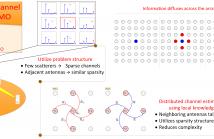
- Read more about DYNAMIC SUBARRAY ARCHITECTURE FOR WIDEBAND HYBRID PRECODING IN MILLIMETER WAVE MASSIVE MIMO SYSTEMS
- Log in to post comments
Hybrid precoding architectures can address the trade-off between achievable spectral efficiency and power consumption in large-scale MIMO systems. Most of the prior work on hybrid precoding focused on narrowband channels and assumed fully-connected hybrid architectures. In this paper, a closed-form solution for OFDM-based wideband hybrid precoding is developed for both fully-connected and subarray architectures in frequency selective channels. The closed form solution provides useful insights into how hybrid subarray structures should be designed.
- Categories:
 33 Views
33 Views
- Read more about Optimal Stochastic Power Control with Compressive CSI Acquisition for Cloud-RAN
- Log in to post comments
This paper considers the channel state information (CSI) acquisition and exploitation problem in cloud radio access networks (Cloud-RAN). A novel CSI acquisition method, called compressive CSI acquisition, is adopted to effectively reduce the CSI signaling overhead by obtaining instantaneous coefficients of only a subset of all the channel links.To deal with the uncertainty in available CSI, we propose a stochastic power control (SPC) framework, which is a highly intractable joint chance constrained program (JCCP).
- Categories:
 11 Views
11 Views
- Read more about Third dimension for measurement of multi user massive MIMO channels based on LTE advanced downlink
- Log in to post comments
We characterize third-dimension (3D) of channel measurements based on two dimension channel model with fully synchronize
- Categories:
 14 Views
14 Views
- Read more about Robust Energy-Efficient Transmit Design for MISOME Wiretap Channels
- Log in to post comments
This paper considers an energy-efficient transmit design in a general multiple-input single-output multiple-eavesdropper (MISOME) wiretap channel. Specifically, a transmitter sends one confidential message to a legitimate receiver, which must be kept perfectly secure from several external multi-antenna eavesdroppers. Assuming imperfect channel state information (CSI) at the transmitter, our goal is to design the input transmit covariance, such that the worst-case secrecy energy efficiency (WC-SEE) is maximized, subject to the quality of service (QoS) and total transmit power constraints.
- Categories:
 18 Views
18 Views
- Read more about Low-Density Spatial RS Design and Channel Estimation for FDD Massive Full-Dimensional MIMO Systems
- Log in to post comments
A low-density spatial downlink reference signal (LDS-RS) design is proposed for frequency-division duplex (FDD) massive full-dimensional multiple-input multiple-output (FD-MIMO) systems. By exploiting the spatial correlation between the channels of different antennas, this scheme can efficiently reduce the downlink RS overhead and therefore enhances the achievable spectral efficiency significantly.
- Categories:
 4 Views
4 Views
- Read more about Achieving Centimeter-level Accuracy for Indoor Localization: A Time-Reversal Approach on WiFi Platforms
- Log in to post comments
- Categories:
 35 Views
35 Views- Read more about Matlab Program for Wireless Powered Two Way Relay Channel (ICASSP 2016)
- Log in to post comments
This Matlab program covers two optimization algorithms, namely semidefinite programming and block coordinate descent method, for wireless powered two way relay channel.
The first algorithm is proposed in:
[1] S. Wang, Y.-C. Wu, and M. Xia, ``Achieving global optimality in wirelessly-powered multi-antenna TWRC with lattice codes,'' in Proc. IEEE ICASSP'16, Shang Hai, China, Mar. 2016, pp. 3556-3560.
The second algorithm is proposed in
- Categories:
 120 Views
120 Views
- Read more about Efficient Coordinated Recovery of Sparse Channels in Massive MIMO
- Log in to post comments
We tackle the problem of estimating sparse channels in massive MIMO-OFDM systems.
The code of our algorithms could be downloaded from Prof. Tareq Al-Naffouri's website http://faculty.kfupm.edu.sa/ee/naffouri/publications/demo_massiveMIMO.zip (597)
or from MATLAB File Exchange http://goo.gl/P19F1Y
- Categories:
 39 Views
39 Views- Read more about Efficient Near Optimal Joint Modulation Classification and Detection for MU-MIMO Systems
- Log in to post comments
A joint maximum likelihood (ML) modulation classification (MC) of the co-scheduled user and data detection receiver is developed
MU-MIMO.pdf
- Categories:
 3 Views
3 ViewsWe propose two computationally efficient subspace detection algorithms, based on a preprocessing stage that consists of special layer ordering, followed by permutation-robust QR decomposition (QRD) and elementary matrix operations.
Subspace.pdf
- Categories:
 7 Views
7 Views